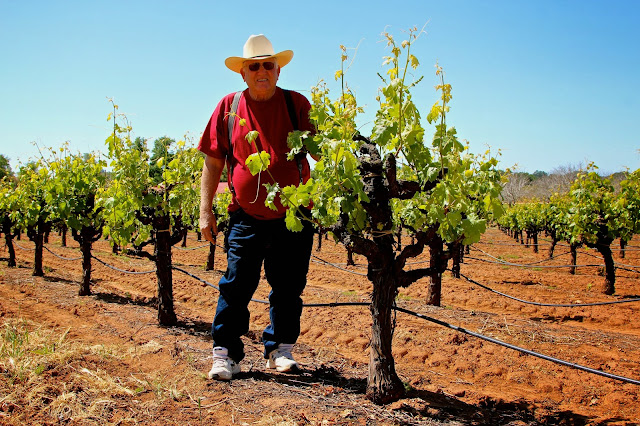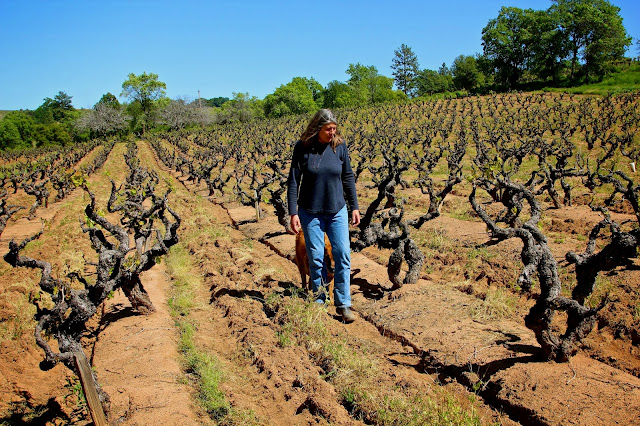Cooper Vineyards Barbera: The dollar that changed a region
 |
| Cooper Vineyards' Dick Cooper among his perfectly sculpted, head trained Barbera |
DickCooper, whose family originally arrived in the Sierra Foothills in 1919, is
generally considered Amador County’s “Godfather of Barbera.” Zinfandel might be Amador’s heritage grape,
but it is a grape that does well in other parts of California. Barbera, on the other hand, makes a red
wine that many of today’s wine lovers believe grows better in Amador County
than just about anywhere else in the world – even as well as the Piedmont
region in Italy, where the grape originated.
That
makes Mr. Cooper’s story an important one indeed; and we’re fortunate that,
although he recently has had to slow down his storied career just a little bit,
he now has more time to tell his tale.
According
to Mr. Cooper, “In the late 1970s we had an abundance of pasture land, 35 acres
of prunes, and walnuts trees on the family property where Cooper Vineyards is
now located. I wanted to put in a
vineyard, but my Dad (Henry “Hank” Cooper) didn’t want anything to do with
grapes. That’s because he’d been
burned a few years earlier, and he was especially done with Zinfandel.
“He
and my Uncle Ken Deaver had gone together on a 40-acre planting of Zinfandel, which
the government was buying up during the war (WW II) to turn into medicinal
alcohol, and was used in hospitals.
They were making good money then – $125 a ton – but after the war the
price dropped to $35 a ton. There
wasn’t anywhere else to take the grapes except to some brokers in Sacramento,
and down the road at D’Agostini Winery – and they weren’t offering more than
$35 either. Dad said, ‘I’ll help
you with 5 acres of grapes, but no more than that.’ He felt we were diversified enough, with the prunes, walnuts
and sheep.
“Now,
my parents loved to entertain.
They always had great parties at the house, inviting the best people
from near and far. Around that
time they had Darrell Corti over.
He was a wine merchant from Sacramento who had influenced a number of wineries
in the Foothills.”
 |
| That fateful dollar bill |
Dad
asked Darrell, ‘If we get back into grapes, what varieties should we
plant?’ Darrell said, ‘Barbera and
Dolcetto.’ Having never heard of
those grapes, Dad asked Darrell if he could write those down for him. Because no one could rustle up a piece
a paper right away, Darrell just took a dollar bill from his wallet, wrote down
Barbera and Dolcetto, and handed it to Dad.
“Since
it was my project, I went out to find cuttings of those grapes to plant. I couldn’t find any Dolcetto, but I
found Barbera from one of our neighbors, Gary Gott at Montevina. So that was how we started with our
first 5 acres of Barbera, in the late ‘70s. It grew pretty well, but in the beginning there was no
demand for it – it got to the point where it was being used primarily to blend,
mostly in White Zinfandel, even though you’re not supposed to do that.
“But
later, winemakers like Scott Harvey, Jeff Runquist, Bill Easton at Terre Rouge,
and a few more wineries in El Dorado were taking the fruit and making some
pretty remarkable wines. The grape
sort of took on a life of its own, and the entire region has become known for
it. From our first 5 acres we’ve
grown to about 100 acres – mostly Barbera, although we grow 16 other varieties
on our ranch.”
The
excellence of Mr. Cooper’s Barbera, not to mention his renown as a grape
grower, took off. Besides
expanding his own vineyards, he has since designed, planted and managed at
least another dozen vineyards in Amador and El Dorado County.
Long
before Mr. Cooper’s forays, the Barbera grape had always been a favorite among
growers and winemakers of Italian descent in San Joaquin Valley and Sonoma County;
regions that still account for most of the 7,000 or so acres planted in the
state. Historically, Barbera was a
major component (along with Zinfandel and Carignan) in blends like E. & J.Gallo’s Hearty Burgundy.
Yet
the Sierra Foothills Viticultural Region has recently become the area most
closely identified with Barbera.
Although plantings in these higher elevations hover around a more modest
300 acres, there are more producers of Barbera in the Sierra Foothills than
anywhere else outside of Italy.
And since 2011, thousands of wine lovers have been attending the annual,
sold-out Barbera Festival, where over 80 producers from throughout California
(plus a few from Italy) gather in June for an all-Barbera/all-the-time
celebration. Shenandoah Valley has
become the New World epicenter of Barbera happenings.
 |
| Dick Cooper tells his tale (over a glass of Cooper Vineyards Barbera) |
According
to Amador County Wine Grape Growers Association spokesman David Logan (whose own Logan's Rock Wall Vineyard in Shenandoah Valley was designed and planted by Dick Cooper – including some of that elusive
Dolcetto!), “Dick Cooper’s ranch has been the home of the Barbera Festival for
several years (in 2015 the festival takes place at Terra d’Oro/MontevinaWinery). Cooper grown Barbera
produced by about a half-dozen wineries have been responsible for almost all the
top Gold or ‘Best of Show’ medals at L.A. County Fair, California State Fair,
the San Francisco Chronicle Wine Competition, and several other competitions in
recent years.”
Yet
the very best may very well be Mr. Cooper’s own bottling: his current release, the 2012 Cooper Vineyards Amador County Barbera
is thick, layered, velvety and fluid – chiseled with every bit of the naturally
zesty, savory, mouth filling, blackberryish flavors you expect in the varietal.
“Truth
be told,” says Mr. Cooper, “the whole Barbera thing came almost as an accident
– a name of a grape jotted down on a dollar bill. It took many more years to actually learn how to grow the
stuff – you can’t grow Barbera like Zinfandel or anything else.”
All
of Cooper’s Barbera plantings are head trained and vertically spur pruned. He has tried trellised systems on his
sandy-clay loam hillsides – a perfect combination of porosity and water
retention, which vines love – but discarded the approach after learning that
the best quality still comes from the free-standing vines. Mr. Cooper’s Barbera plants are primarily
FPS Clone 06 (from U.C. Davis’ Foundation Plant Services) grafted onto St. George rootstock – plant material sometimes called the “Cooper clone Barbera,” out of
respect for its “Godfather.”
Still,
unlike Zinfandel, says Mr. Cooper, “You need to leave more spurs per vine on
Barbera to get a little more shade, and you learn to drop seconds (i.e. late
blooming clusters). Barbera likes a little sun after veraison (i.e. when berries turn from green to black),
but before veraison it’s a disaster.
It’s also susceptible to powdery mildew, so you have to be vigilant with
the sprays.
 |
| Recently planted Black St. Peter clone Zinfandel in Cooper Vineyards |
“We go for Barbera that’s a little more fragrant and fruit-forward – it always has more than enough acid and body. Not to be critical, but we feel this makes a better wine than the harsh, under-ripe styles you often get from Italy. I love it when Italian winemakers come and visit, walk around the vineyard and ask us how we do it. They may be the ones who started it, but now they learn from us!
“If
anything, we’ve learned to be patient with the grape. It usually takes a while before its acids, which are
notoriously high, start to go down.
If you have to wait until sugars climb to 28° Brix, which you have to balance out in a winery
(usually by adding a little water to lower alcohol levels to a more ideal 14%
range), this is preferable to making a wine that’s hard to drink or weak in
flavor.
“When
we decided to produce our own wine, we planned our winery and tasting room for
about 2,500 cases. We’ve been so
successful, though, that it’s grown to 10,000 cases, and we’re now taking more
(about 45%) of our own fruit, and selling to fewer of those top winemakers.
“But
I think we’ve reached capacity. I've had some recent health issues, so I can’t spend nearly as much time out on the
tractor as I’d like to. But I have
vineyard foremen who have been with me for 12, 16 years. The vineyard is in good hands – they
know what they’re doing, maybe even better than me. And my four daughters are all involved in the operations.
“Our
winemaker (Cooper Vineyards’ Michael Roser) is doing a great job, and he’d love
for me to plow up a little more of the landscape to make room for more tanks
and barrels. But I think I like
the free space around the property looking the way it is.
“That
dollar bill Mr. Corti had written on – we misplaced for a little while, but my
daughter Chrissy recently went looking for it, and she found it. It’s now hanging up behind our tasting
room bar – a constant reminder of how it all got started!”






Comments